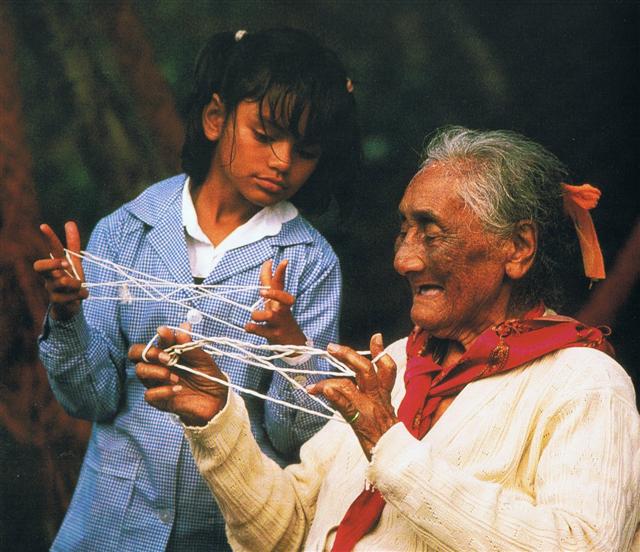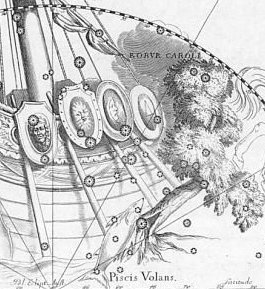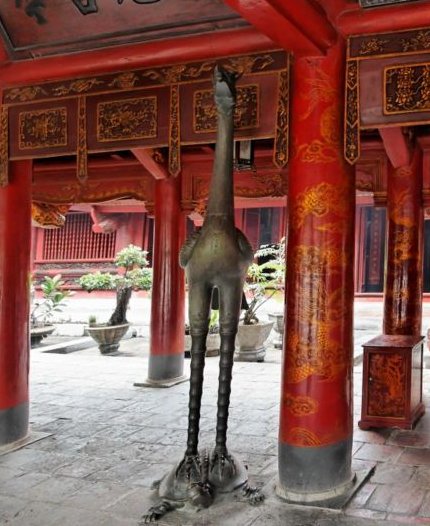Bb10.8
Deep down in the cave home dwellings of our old cousin the spear-armed Neanderthal
there were wall paintings illustrating not only animals and people but also
what evidently must be regarded as more abstract figures. There were
32 such characters. This new piece of information
excavated by a modern day scientist (Genevieve von Petzinger) - which became known to me by way of
a TV program last night - makes food for thought. Possibly they
sat comfortably at the entrances with cooking fires warming their backs, looking out at the
glorious night sky which was slowly moving up in the
east and down in the west.
They could easily have made strings to better perceive when
the great stars were passing across some predetermined elevations,
for instance 32º apart.

Anciently
all knowledge was potentially essential for survival and what gradually had
accumulated were surely not forgotten. Knowledge was much more valuable than
gold.
... 'Most ingenious Thoth', said the god and
king Thamus, 'one man has the ability to beget arts, but the
ability to judge of their usefulness or harmfulness to their
users belongs to another; and now you, who are the father of
letters, have been led by your affection to ascribe to them a
power the opposite of that which they really possess.
For this invention will produce
forgetfulness in the minds of those who learn to use it, because
they will not practise their memory. Their trust in writing,
produced by external characters which are no part of themselves,
will discourage the use of their own memory within them. You
have invented an elixir not of memory, but of reminding; and you
offer your pupils the appearance of wisdom, not true wisdom, for
they will read many things without instruction and will
therefore seem to know many things, when they are for the most
part ignorant and hard to get along with, since they are not
wise, but only appear wise.'
I guess the position of Dramasa, 10 * 32 = 320 right
ascension days after 0h, was no arbitrary fact. A game board for
chess carries 32 white and 32 black squares. If you would place 1 seed
on the 1st square, 2 on the 2nd, 4 on the 3rd, etc, in geometric
progression you would find 32 on square number 6:
|
1 |
2 |
3 |
4 |
5 |
6 |
7 |
|
1 |
2 |
4 |
8 |
16 |
32 |
64 |
|
1 |
10 |
100 |
1000 |
10000 |
100000 |
1000000 |

... Ogotemmêli had his own ideas about
calculation. The Dogon in fact did use the decimal system,
because from the beginning they had counted on their fingers,
but the basis of their reckoning had been the number eight and
this number recurred in what they called in French la
centaine, which for them meant eighty. Eighty was the limit
of reckoning, after which a new series began. Nowadays there
could be ten such series, so that the European 1,000
corresponded to the Dogon 800. But Ogotemmêli believed that in
the beginning men counted by eights - the number of cowries on
each hand, that they had used their ten fingers to arrive at
eighty, but that the number eight appeared again in order to
produce 640 (8 x 10 x 8). 'Six hundred and forty', he said, 'is
the end of the reckoning.' According to him, 640 covenant-stones
had been thrown up by the seventh Nummo to make the outline in
the grave of Lébé
...
Obviously the thoughtful Neanderthals
would have seen how the gradual doubling of any
amount of small stones would soon expand beyond reach and
eventually grow even beyond the immense amount of stars visible above.
Their children would have seen and immediately have understood. This discovery could be used to document all
sorts of things, for instance by using knots on strings in
a binary system.
 |
 |
|
 |
 |
 |
|
Bb10-3 (379) |
Bb10-4 |
Bb10-5 |
Bb10-6 |
Bb10-7 |
|
HELIACAL
STARS: |
|
CASTRA = ε Capricorni
(327.2),
BUNDA (Foundation) = ξ Aquarii
(327.5)
SIRIUS (α Canis Majoris) |
Mahar sha hi-na
Shahū-26 (Western One in the Tail of the Goat)
NASHIRA (Fortunate One) = γ Capricorni
(328.0),
ν
Oct. (328.3),
AZELFAFAGE (Horse's Foot Track) = π¹ Cygni,
κ
Capricorni (328.7) |
|
Arkat sha hi-na
Shahū-27 (Eastern One in the Tail of the Goat)
ENIF (The Nose) =
ε
Pegasi,
ERAKIS (the Dancer) = μ Cephei
(329.2),
46 CAPRICORNI,
JIH (the Sun) =
κ
Pegasi
(329.3),
ι
Piscis Austrini (329.4),
λ
Capricorni (329.6),
ν
Cephei (329.7),
DENEB ALGIEDI =
δ
Capricorni
(329.8)
*288.0 = *329.4 - *41.4 |
θ
Piscis Austrini (330.1),
λ
Oct.
(330.7) |
KUH (Weeping)
=
μ
Capricorni (331.4),
γ
Gruis (331.5)
*290.0 = *331.4 - *41.4 |
|
12 |
Aug 13
(225) |
14 (409 -
183) |
15 (227) |
16 |
|
Febr 11 (42) |
12 (408 = 365
+ 43) |
13 (226 +
183) |
2-14 (→ 14 *
29½ - 3) |
15 (411 = 350
+ 61) |
|
DEC 12 |
LUCIA (*264) |
14 |
15 |
16 (350 → 347
+ 3) |
|
kua moe ma te tara huki
|
kua ati ra te kava - kua
hakaroa - ko te kava ma te hatu huri |
i vai o amo
hia |
eko te maitaki ma te hokohuki
ku hura hia |
ki te vai o amo
hia |
|
Amo. To carry on one's
shoulders: O Yetú i-amo-ai te tatauró ki ruga
ki-te maúga Kalvario. Jesus carried his
cross up to the Calvary. Amoga, bundle;
to tie in a bundle: he-amoga i te hukahuka,
to tie a bundle of wood. Vanaga. 1. A yoke,
to carry; amoga, burden, load. 2. To
bend, to beat a path. Churchill. Âmo. 1.
To clean, to clean oneself: he-âmo i te umu,
to clean the earth oven; ka-âmo te hare,
ka haka-maitaki, clean the house, make it
good; he-âmo i te ariga, to clean one's
face wetting it with one's hand. 2. Clear;
ku-âmo-á te ragi, the sky is clear. 3. To
slip, to slide, to glide (see pei-âmo).
Ámoámo, to lick up, to lap up, to dry; to
slap one's body dry (after swimming or bathing):
he-âmoâmo i te vaihai rima.
Vanaga. Amoamo. 1. To feed, to graze. 2.
To spread, to stretch (used of keete).
Churchill.
... In China, every year about the beginning of
April, certain officials called Sz'hüen
used of old to go about the country armed with
wooden clappers. Their business was to summon
the people and command them to put out every
fire. This was the beginning of the season
called Han-shih-tsieh, or 'eating of cold
food'. For three days all household fires
remained extinct as a preparation for the solemn
renewal of the fire, which took place on the
fifth or sixth day after the winter solstice
[Sic!]
...

... Once upon
a time there was an old woman who owned a great
potato field where she planted her potatoes in
spring and harvested them in autumn. She was
famous all around for her many varieties of
wonderful potatoes, and she had enough of them
to sell at the market place. She planted her
potatoes 7 in a row, placing her foot in front
of her as a measure from one potato to the next.
Then she marked the place with a bean - which
would also give nourishment to the surrounding
potatoes. Next she changed variety and planted 7
more followed by another bean, and this was the
pattern she followed until all her 214 varieties
had been put down in their proper places. She
had drawn a map which she followed and from
where each sort of potato could be located at
the proper time for its harvest. I was
fascinated, when I happened to stumble on this
Swedish TV program, because my 'once upon a
time' was now and 214 (= 2 * 107) was surely no
coincidence. She knew what she was doing. Let's
therefore count: 214 * 7 (potatoes) + 213
(beans) = 1711. So what? Probably because 1711 =
59 * 29 ...
... Early on Sunday morning, 14 February 1779,
Captain Cook went ashore with a party of marines
to take the Hawaiian king, Kalaniopu'u, hostage
against the return of the Discovery's cutter,
stolen the night before in a bold maneuver - of
which, however, the amiable old ruler was
innocent. At the decisive moment, Cook and
Kalaniopu'u, the God and the King, will confront
each other as cosmic adversaries. Permit me thus
an anthropological reading of the historical
texts. For in all the confused Tolstoian
narratives of the affray - among which the
judicious Beaglehole refuses to choose - the one
recurrent certainty is a dramatic structure with
the properties of a ritual transformation.
During the passage inland to find the king,
thence seaward with his royal hostage, Cook is
metamorphosed from a being of veneration to an
object of hostility. When he came ashore, the
common people as usual dispersed before him and
prostrated face to earth; but in the end he was
himself precipitated face down in the water by a
chief's weapon, an iron trade dagger, to be
rushed upon by a mob exulting over him, and
seeming to add to their own honors by the part
they could claim in his death: 'snatching the
daggers from each other', reads Mr. Burney's
account, 'out of eagerness to have their share
in killing him'. In the final ritual inversion,
Cook's body would be offered in sacrifice by the
Hawaiian King ...
... The Hawaiian woman who was interviewed
chuckled because the assassination of Captain
Cook coincided with the day we have named All
Hearts' Day - when in February 14 (2-14) the
war-god Kuu returned to power ...
 |
|
RIGHT
ASCENSION DAYS AT THE FULL MOON: |
|
A
Hydrae
(144.1)
VEGA (α Lyrae) |
Creation of our present world
UKDAH (Knot) =
ι
Hydrae (145.4),
κ
Hydrae (145.5),
SUBRA =
ο
Leonis
(145.8)
ALPHEKKA
MERIDIANA
*104.0 = *145.4 - *41.4 |
|
5 Imix 9 Kumk'u
Rishu A.-13 (Head of the
Lion)
ψ
Leonis (146.4),
RAS ELASET AUSTRALIS
(Southern Head of the Lion)
= ε Leonis
(146.6)
*105.0 = *146.4 - *41.4 |
VATHORZ PRIOR = υ Carinae
(147.9)
|
υ¹
Hydrae (148.4),
RAS ELASET BOREALIS (Northern Head of the Lion)
=
μ
Leonis
(148.7)
*107.0 = *148.4 - *41.4 |
|
12 |
Aug 13
(225) |
14 (409 -
183) |
15 (227) |
16 |
 |
 |
 |
|
Bb10-8 |
Bb10-9 |
Bb10-10 |
|
Aug 17 |
18 (230) |
19 |
|
No star listed (300 + 32) |
η Piscis Austrini (333.4)
*292.0 = *333.4 - *41.4 |
Rooftop-12
(Swallow)
22h (334.8)
KAE UH (Roof) = ο Aquarii
(334.0),
AL KURHAH (White Spot) = ξ Cephei (334.4),
SADALMELIK (Lucky King) = α Aquarii, AL DHANAB
(The Tail) = λ Gruis (334.6),
ι Aquarii, ν Pegasi (334.7)
*293.0 = *334.4 - *41.4 |
|
RIGHT
ASCENSION DAYS AT THE FULL MOON: |
|
TSEEN KE (Heaven's Record) =
φ
Velorum
(149.9) |
ν Leonis (150.1), π Leonis (150.6) |
υ² Hydrae (151.8) |
|
Heaven's Record is the star
which arrives high up and half hidden in the
dark foliage of the beginnning of
Robur
Carolinum:
 |
|
ko te ravarava ku moe |
eaha te goe moe |
ki te henua - e tagata era
|
|
Goe. Milky Way. Vanaga. |

|













